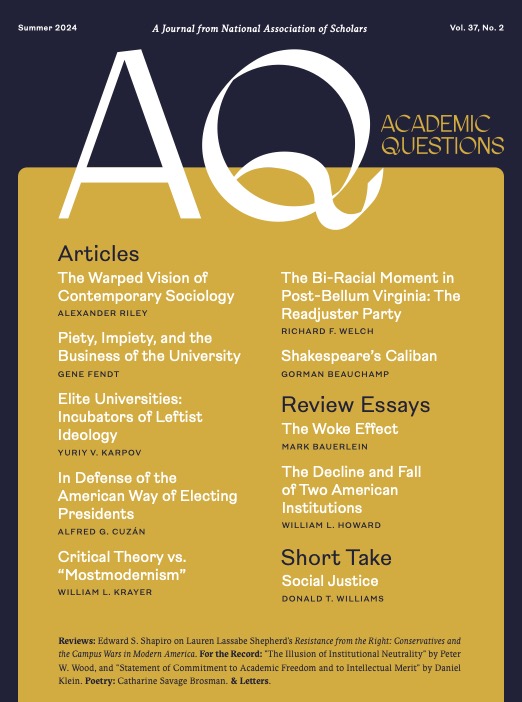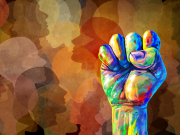The Democrat Party Hates America, Mark R. Levin, Threshold, 2023, pp. 400, $30.
American Gulags: Marxist Tyranny in Higher Education and What to Do about It, Oliver L. North, David L. Goetsch, Archie P. Jones, Fidelis, 2023, pp. 160, $20.
In these books, the conservative authors critique two institutions most responsible for the rapid and radical deformation of American culture: the Democrat Party and higher education. Besides the media, no other institutions promote radical change so relentlessly. Both books serve up red meat for the conservative base. But they are written from perspectives outside the institutions they seek to examine, and thus have attained a certain critical advantage. Read together, the two studies clarify the degree to which institutions of higher education have come to resemble a political party. The parallel, near unanimous ideological closed-mindedness of higher education reverses its historic mission.
In his autobiography, Malcolm X traces the destruction of his family to the likely murder of his father by the racist Black Legion and the toxic meddlesomeness of social workers who undermined his widowed mother. Whether the murderers and welfare workers were card-carrying Democrats, we do not know. But after reading The Democrat Party Hates America, what a few decades ago might have been an irrelevant if not preposterous speculation, becomes a legitimate question. Just how pervasive is the damage the Democrat Party has done to American society and for how long has it been doing it? Considering its recent lurch to the left and its efforts to “transform America”—seemingly by uprooting its core values—the argument that this party must hate the America embodied in the Declaration of Independence and Constitution deserves to be heard. A key question is whether today’s woke Democratic Party is a direct descendent of the old Southern-dominated Democratic Party of the Jim Crow era, or whether these are disjunct in philosophy as well as time.
The author of The Democrat Party Hates America Mark Levin is a Fox political commentator and the author of several books critiquing the Left’s political and cultural influence. Devoting two of his chapters to racial politics, Levin makes the case that, historically, mostly through its influence in the South, Democrats were complicit in racist acts of violence against black people, malevolent discriminatory policies, and, even when prescribing solutions to their social problems, an arrogant disregard of their basic humanity. The assumption of the Democrat Party, whether operating with hostile or benevolent intent, has apparently been that American citizens are not independent, dignified moral agents capable of self-government. In their view of the disadvantaged especially, Democrats assume they are unable to overcome many of life’s obstacles, are in need of Democrats’ help, and that there is something uncommonly righteous in themselves for offering it.
Since its founding, Levin argues, the Democrat Party has used racial politics for its own power-mongering. In the antebellum and Jim Crow periods, race baiting at the expense of blacks was one of the party’s most effective tactics for getting out the white vote. President Woodrow Wilson undermined decades of progress integrating freed slaves into American society when he resegregated the United States government in the early twentieth century. Although the party of Presidents Kennedy and Johnson is routinely credited with instituting civil rights reforms in the 1960s, less than 40 percent of Democrat congressmen supported the 1964 Civil Rights Act, compared with over 80 percent of Republicans. Yet, a common Democrat political tactic since that time has been to label Republicans racists. Since the 2020 election, Democrat race-baiting has been reprised, this time against whites to secure the votes of “people of color.” The commonality between the racist Democrat Party of the past and the “anti-racist” one of today, Levin maintains, is that this political party has always appealed to the lowest, most savage impulses to amass power for itself. It remains as deterministic as the most unrepentant nineteenth century racist. That it wraps itself in racial benevolence makes it perhaps the most hypocritical of all the institutions in the country.
Levin uses President Joe Biden as a representative example of the modern Democrat. Early in his career, he was friends with John Stennis and Robert Byrd, segregationist senators from the South, and spoke publicly about his fears of a racial jungle when busing was being debated in the U.S. Senate. He led efforts to defame Clarence Thomas when he was nominated to the U.S. Supreme Court and threatened President George W. Bush with a filibuster if Janice Rogers Brown were nominated as the first black female Supreme Court justice. As president, Biden’s repeated attacks on the half of the country who did not vote for him and his purveying of the myth that white supremacy is “a poison running through our body politic” recall his party’s former race-baiting tactics. The “consummate political chameleon,” as Levin terms him, President Biden represents the long history of the Democrat Party’s willingness to use racial division as a source of political power even though damaging to the country’s unity.
Levin also devotes a chapter to what he calls the “war on the nuclear family.” The Democrat Party, Levin maintains, has shown that it has a vested interest in singleness and broken families. Considering voting patterns based on gender and marital status, Levin points out that single women constitute one of the largest segments of the voting public that prefers Democrat candidates, and overwhelmingly so, at 68 percent. The party of centralized government control administers to a vast number of women, subsidizes their abortions and their welfare dependency in addition to sponsoring affirmative action and preferential legislation to crack “the glass ceiling.” Women and children living outside the two-parent family constitute most of the wards of the state.
Levin makes the case that society’s embrace of alternatives to marriage and family and the values formed within them is being promoted by the Democrat Party, just as it promotes racial divisions, to enhance its political power. The ideology behind its policies is Marxist, argues Levin. The Communist Manifesto was explicit in denouncing the traditional family and applauded the relative absence of strong family ties among the proletariat because it facilitated the state’s appropriation of its children.
As for the shrinking number of American children who are not beneficiaries of government largesse (those largely from traditional families), they are soon subjected as students in public schools (“government schools,” as Levin calls them) to Marxist indoctrination. One of the Democrat Party’s staunchest allies, teachers’ unions, inculcate Leftist ideas clearly at odds with traditional students’ family values, not to mention with American values. To detach children from their families is effectively to place them under the control of the educational system and the state. That in turn ensures that a growing number of them will be surrendered to the healthcare system for “gender affirming care” and to a permanent dependence on the state for laws to protect them from “phobias” (more accurately, natural responses to deviance) and to force their integration into society. As Levin succinctly summarizes, “The Democrat Party has made clear that it intends to subjugate children, the younger the better, to the ideological and political purposes of the party.” The educational system’s brazen effort to divide children from their parents has the backing of President Biden’s Justice Department. Levin calls its efforts to intimidate parents protesting indoctrination of their children at school board meetings “nothing more than an attempt to silence constitutionally lawful assembly and dissent under the First Amendment.”
Democrats have resisted any legislative initiatives to protect nuclear families and traditional gender roles. The Republican-sponsored Parents Bill of Rights Act, which included provisions that ensured the “right to be heard” and the “right to protect their child’s privacy” barely passed the House 213-208 with every Democrat voting no. There were similar results when legislation to protect females from having to compete with males in sports was proposed in The Protection of Women and Girls in Sports Act, which would amend Title IX by specifying that the word “sex” “shall be recognized based solely on a person’s reproductive biology and genetics at birth.” It passed the House 219-203 with no Democrats supporting.
The unpleasantness of Levin’s title compelled socially sensitive retailer Target to hide this book for fear of offending customers. Target, one remembers, is the retail store that prominently displayed transgender onesies for infants until an outcry from the public forced it to underplay the fashion innovation. A counter-outcry concerning Levin’s book apparently has brought it back to full display. The public is sluggish but beginning to react to reports of the Left’s aggressive tactics.
Levin’s title is sensational but arguably justified—if justified at all—by the need to catch the attention of that portion of the public not yet aware of the circumstances.
Upon reading American Gulags: Marxist Tyranny in Higher Education I was reminded of a time when I was teaching “The Parable of the Prodigal Son” and the book of Jonah in a World Masterpieces literature course. A student cautiously asked, “Are we supposed to be reading these?” It was not a strident protest, and it did give me the opportunity to say, in effect, “We live in a free country, don’t we?” But still, her doubts seemed a sad commentary on how thoroughly the university (or the government or both) has overshadowed teaching and learning with a kind of threat—including the looming possibility of censorship of the most influential book in the world.
American Gulags notes what it calls a “totalitarian” tendency in American higher education, and the book calls out the intimidation, groupthink, and assaults on freedom of expression increasingly common. This book is not only a manual for college bound students and their parents and grandparents but is intended “for all Americans who are concerned about the Leftist tidal wave that has swept over our country covering society in the detritus of moral decay.” To fix the problem, Americans should focus on college and university campuses: “It is here your efforts have the most potential to bear fruit.” The book describes what to expect from the woke university: namely, hostility to conservatives and Christians.
The three authors identify themselves as fathers, grandfathers, and former Marines who all graduated from the U.S. Naval Academy. Oliver North is a well-decorated veteran of the Viet Nam War and worked on the National Security Council under President Ronald Reagan. David Goetsch and Archie Jones spent the bulk of their careers in academe. Their book is not a scholarly work, but that may be an advantage. Like Levin’s book, this book implies the necessity of looking from outside an institution to discern the ideology that has corrupted it. It is not interested in mitigating factors and alternative interpretations that might be offered by, say, academic administrators. The authors assume a kinship with common Americans and a shared outrage at the university elite’s contempt for the traditions that, a generation ago, were still highly regarded. Essentially, their book holds higher education accountable to consumer citizens: those who have seen not only a decline in quality but a dangerous betrayal of their country as well.
This book makes a clear distinction between education and indoctrination and finds American higher education now devoted to the latter. Whereas education broadens, indoctrination narrows. “Education encourages debate, informed disagreement, openness to new ideas, and exposure to a wide range of opinions, worldviews, and perspectives. Indoctrination discourages all of these things, and, instead, demands intellectual submission, obedience, and conformity.”
One priority of the ideological university is to obscure or discredit the truth that America and most of its colleges were founded by Christians and based on Christian principles. The authors note that universities have long been more liberal than the surrounding society, but “their propensity for condoning and even encouraging the suppression of Christian and conservative thought is a relatively new development, [an] overt anti-Christian crusade.”
Identity-centered degree programs especially lend themselves to indoctrination. The one-dimensional Marxist assumptions of these programs work harmoniously with the method of indoctrination to encourage students to adopt—superficially—the mentality of the oppressed. Marxist indoctrination leads inevitably to spoon-feeding students a one-dimensional view of American culture. It demands a system “bloated with ‘administrators’” to enforce ideology. It demands educational standards be lowered. A National Endowment for the Humanities study found that most college seniors could not pass “even a basic-level test on Western culture and history; 25 percent could not distinguish between the principles advocated by Karl Marx and those found in the U.S. Constitution; 42 percent could not place the Civil War in the correct half-century.”
The authors weigh in on the $1.5 trillion student indebtedness crisis. First, they reject proposals to make college free because that would simply mean taxpayers, including those not attending college, would pay for the entirety of someone else’s education. Of approximately 250 million adults in America, 45 million carry student debt backed by the federal government. As it stands, state taxpayers already pick up the tab for approximately 60 percent of student college costs.
A second problem is that free college education “makes no distinction between legitimate college degrees in high-demand fields and the feel-good identity degrees favored by Marxist college professors and administrators.” A third problem is that loans backed by the federal government create moral hazards. Students are recklessly allowed to borrow amounts they may never pay back, and banks can lend irresponsibly because they know that they will not lose if the student defaults. The facile solution of “loan forgiveness,” the authors maintain, is an example of the Left’s use of “semantic subterfuge”: “creating an inoffensive name for an offensive concept.” More accurately, loan forgiveness simply means “debt transference”: “transferring the debt from the students who incurred it to taxpayers who did not.”
The authors’ military backgrounds provide a unique aspect to their arguments and a reminder that early college loan programs were “national defense loans.” For these authors, poorly trained students are a major security issue. A country taught to hate itself will inevitably lack the will to defend itself. And a country educated to be stupid will lack the intelligence to defend itself. “While foreign students in American universities are learning how to hack into and disable America’s electrical grid and computer-controlled systems, U.S. students are sitting through little more than amateur therapy sessions.”
America can only compete globally if it can “outthink, out-innovate, and outwork” rivals. To this end, North, Goetsch, and Jones argue that federally backed loans should be prioritized for those pursuing degrees that meet “a legitimate national need.” Those loans should serve as investments in the country’s future rather than be subsidies of anti-American self-indulgence.
The counter-revolution has apparently reached no consensus about how to designate its enemies. While the radical revolutionaries on the Left demonize their opponents with terms like “racists,” “white supremacists,” “colonialists,” “homophobes,” or “transphobes,” the authors of these books use the rather mild “Woke,” “the Left,” “Progressives,” “Marxists,” and “Democrats.” The authors of American Gulags explain that they use several terms interchangeably for "those who want to tear our nation apart so it can be rebuilt to their vision of total government control and the subjugation of its citizens.”
But if the enemy is so bent on destruction, it would be advisable to find terminology negative and forceful enough to effectively combat it. Although “Marxist” has some justification—Marx assumed the oppressor/oppressed binary and called for revolution—today’s vindictive intellectual hatred, news media manipulation, denunciation of thought crimes, cancellation of divergent views, and show trials of political enemies do not recall the shabby economist so much as the methods of those who implemented his ideas in the twentieth century.
It might be more accurate to term them Leninist, Stalinist, or Maoist. Christopher Rufo’s recent book America’s Cultural Revolution (2023) adds more recent names to the list of suspects: Herbert Marcuse, Angela Davis, Paulo Freire, and Derrick Bell. They represent those who have redirected the focus of attack from economic fissures to more visceral cultural and racial ones, something perhaps too devious for even Marx and his early followers to envision.
The cold warriors who wrote these two books once had at their command an appellation that served well in the latter half of the twentieth century and is not without applicability today: “Commie.” But to use the term now would only invoke a snicker, even from much of the conservative intelligentsia. Thus, our cultural arbiters have successfully whitewashed the traitors of the past and discredited those who fought them. Being an over-zealous McCarthyite, the Left has firmly established, was contemptible; being a Communist conspirator, a matter of conscience. The result, as North, Goetsch, and Jones aver, is that Americans are even less able to recognize threats to their way of life than they were in the past.
However imperfect the terms they use, these two counter-revolutionary studies help unearth the entrenched forces of privileged radicalism undermining civilization. They help unmask the saboteurs who have adopted the brutal methods of twentieth-century propaganda and applied them to our time, willfully disregarding, distorting, or falsifying the truth in promoting narratives that afford themselves power.
William L. Howard is Professor of English (ret.), Chicago State University. His most recent article in Academic Questions was “The Ivory Tower and the Oil Pit,” a review of Will Bunch’s After the Ivory Tower Falls (2022) for our Spring 2024 issue.
Photo by Hisham Zayadneh on Unsplash














